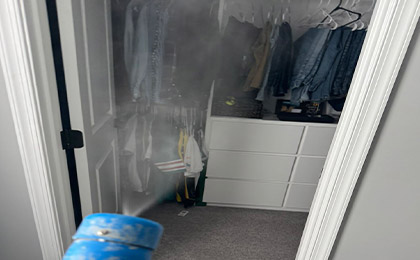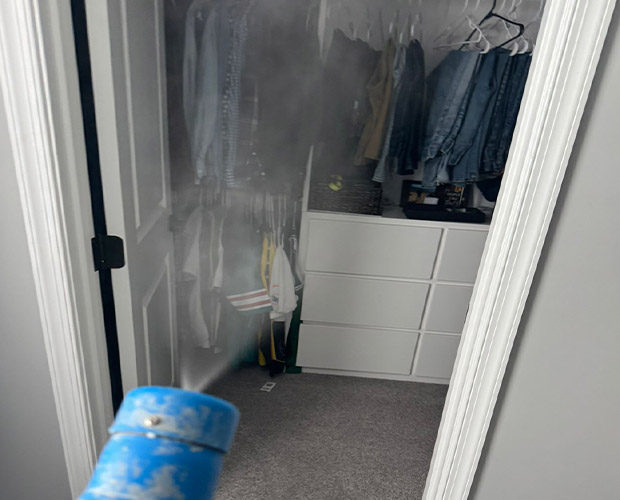
Mold in Closet: How to Spot and Remove
The last thing anyone wants to discover in their closet is mold. This unwelcome intruder can quietly hide behind your clothes or settle on your shoes, often going unnoticed for long periods. It usually remains concealed until you discover it while reaching for a long-forgotten item from the shelf.
While finding mold can be unsettling, knowing how to address it will help you regain control of the situation. As you assess the issue, you may find yourself asking: How did this happen? What caused it? Can it affect your health?
These questions are critical, as understanding the answers is key to addressing the problem effectively. Mold can pose various health risks, so evaluating its effects should always be your first step. Once you understand the potential risks, identifying the type of mold will help you determine the best course of action.
Identify the Type of Mold in Closet
Understanding the type of mold you're dealing with is crucial because it directly affects the removal process. Some types are less harmful, while others pose significant risks to your health and home. Let's delve into this further, starting with the most dangerous type of mold.
Black Mold vs. Mildew in Closets
Black mold is not only the most dangerous but also one of the trickiest to identify. While it is often more noticeable than other types of mold, it tends to hide in dark corners, such as behind clothes.
What might begin as a small black patch on a wall can quickly grow into a larger colony of black mold if left unnoticed. Black toxic mold is particularly hazardous because it releases mycotoxins as it grows. Another complicating factor with black mold is that it can easily be mistaken for mildew.
Mildew often appears as small, dark gray dots, but the effects of exposure are far less severe. In contrast, mycotoxins released by black mold can cause serious health issues, including damage to the brain, immune system, and respiratory system.
Black mold also thrives in areas with persistent moisture, making it a potential indicator of hidden problems, such as a leak behind a wall or concealed water damage. On the other hand, mildew typically grows on surfaces with poor air circulation and high humidity, rather than in areas directly affected by water damage.
Green Mold in Closets
Next, we have green mold - a fuzzy fungus with a powdery texture. As the name suggests, it is green in color and, while slightly less harmful than black mold, still produces mycotoxins that can pose health risks. Like black mold, green mold often starts as small patches and expands into larger areas if left untreated.
Green mold, like its black counterpart, thrives in moist environments and is often a sign of a leak or past water damage. While it may be less dangerous overall, addressing green mold promptly is just as important to prevent further spread and potential health risks.
White Mold in Closets
The final type of mold to consider is white mold. This fuzzy intruder is often found in closets because it thrives on damp items. Unlike black and green mold, white mold tends to prefer organic materials, such as clothes, leather shoes, or wood. However, that doesn't mean synthetic fabrics in closets are entirely safe - white mold spores are airborne and can settle on almost any surface.
While white mold is less aggressive than black or green mold, it can still release mycotoxins and should not be ignored. Its growth typically remains on the surface, making it less likely to spread as extensively. However, if left untreated, it can still cause damage and health issues.
What to Do With Mold in My Closet?
If you've discovered mold in your closet, the first step is to remove all clothes and shoes and place them in fresh air and direct sunlight. This helps eliminate some mold spores and reduces the musty odor. Once the closet is empty, you can assess the extent of the damage, identify the type of mold in your closet, and determine the next steps based on the mold type and the surface it's growing on. Here's how to proceed:
1. Address Black Mold or Green Mold
Black toxic mold and green mold in closets are more serious problems, as they often indicate that your closet has water damage or persistent moisture issues. The first priority is to locate the source of the moisture, such as a hidden leak or damp conditions, and resolve it.
If the mold is on drywall, the affected area will likely need to be removed and replaced. Drywall is porous, and mold tends to penetrate deeply, making it nearly impossible to clean effectively.
2. Manage Mildew or White Mold
Mildew and white mold are less severe but still require attention. The removal process depends on the surface the mold is growing on:
- Fabrics and Footwear: Mold on clothes and shoes is usually manageable. Removing mold from clothes is a multistep process that includes drying in fresh air, brushing off visible mold, soaking in vinegar, and machine washing with specialized detergents. For shoes, specific cleaning solutions, such as vinegar or alcohol-based cleaners, can work.
- Hardwood or Walls: If mildew or white mold is found on walls, wood, or other solid surfaces, the treatment will differ. Mildew on walls requires cleaning with appropriate mold removal products and may not require replacement unless the damage is extensive.
3. Determine What You Can Handle vs. When to Call a Professional
At this stage, assess whether you can safely and effectively remove the mold on your own or if professional help is needed.
- DIY Approach: Small areas of mold on non-porous surfaces, like concrete, can often be cleaned using a mixture of vinegar and water (1:1 ratio). Spray the mixture on the affected area, let it sit for 15 minutes, and then wipe with a damp cloth. For tougher cases, commercial mold removers can be applied, followed by scrubbing with a brush.
- Professional Help: If you are unsure of the mold type or it has spread extensively, a professional mold inspection is the most reasonable option. Professionals can help assess the extent of mold contamination in your home and identify areas that require targeted mold removal service, ensuring the problem is fully addressed and doesn't spread further.
4. Important DIY Limitations to Consider
While DIY methods can be effective for smaller, surface-level mold problems, they are not guaranteed to resolve the issue entirely. Porous materials like drywall or untreated wood may require professional removal to ensure the mold does not return. Always use protective gear such as gloves, goggles, and a mask when handling mold.
Conclusion
Discovering mold in your closet can feel overwhelming but addressing it promptly and effectively is essential for protecting your home and health. Understanding the type of mold and its severity is the first step toward determining the best course of action. While DIY methods may work for minor surface-level issues, extensive mold contamination or black mold requires professional attention to ensure thorough remediation.
When faced with stubborn or widespread mold, contacting professionals like Mold Act is a smart choice. Our expertise ensures accurate identification of mold types, targeted remediation plans, and long-term solutions to prevent recurrence. We are equipped to handle the complexities of mold removal, giving you peace of mind and restoring your living space to a safe and healthy state.
Don't wait for the problem to escalate. Take control by addressing mold in your closet today - whether through careful DIY efforts or by reaching out to our specialists at Mold Act. We specialize in tackling mold with precision and expertise. A mold-free home starts with the right steps, and the sooner you act, the better.



Mold Remediation Services

